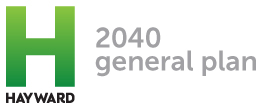Mobility, defined as the ability to move people and goods within and through a city or region, greatly affects a community’s economy, environment, and overall quality of life. When mobility networks are overburdened and inefficient, communities can fail to live up to their full potential, and the economy and overall quality of life can suffer. Time is lost in traffic congestion, businesses are less efficient and less profitable, energy resources are wasted, and air quality and natural resources are degraded. In contrast, efficient and convenient mobility networks, when combined with compatible land use patterns, have the potential to increase economic efficiency, reduce pollution and greenhouse gas emissions, and improve community health and quality of life.
The Mobility Element establishes goals and policies to improve the mobility of people and goods within and through the city of Hayward. Rather than focusing on automobile transportation, the Mobility Element seeks to create a balanced transportation network that supports and encourages walking, bicycling, and transit ridership. The goals and policies address a variety of topics, including multimodal transportation, regional coordination, complete streets, local circulation, pedestrian facilities, bikeways, public transit, transportation demand management, parking, aviation, goods movement, and transportation funding. A number of the goals and policies also serve as Climate Action Plan actions, which are designed to reduce local greenhouse gas emissions.
The goals and policies in the Mobility Element are interrelated with several of the Land Use and Community Character goals and policies, particularly as they relate to the City’s s (areas served by regional transit) and the creation of complete, walkable, and transit-oriented neighborhoods, corridors, and districts. The Community Health and Quality of Life Element also has supporting policies related to walking and bicycling.
The Mobility Element is divided into two sections. The first section provides an overview of the Transportation Diagrams. The Transportation Diagrams shows the transportation network that are planned to serve the future land uses within the City. The Transportation Diagram is closely aligned with the Land Use Diagram provided in the Land Use and Community Character Element. The second section of the Element contains the mobility goals and policies.
Transportation Diagrams
The transportation networks that are planned to serve the future land uses within the city are identified in the following figures:
- Figure M-1: Planned Roadway Network: This figure identifies the network of existing and proposed freeways, highways, and arterial streets that are planned to serve the future land uses within the city.
- Figure M-2: Planned Bicycle Network: This figure identifies the network of existing and proposed bike paths, bike lanes, and bike routes that are planned to serve the future land uses within the city.
- Figure M-3: Planned Transit and Passenger Rail Network: This figure identifies the network of existing and proposed bus, BART, and passenger rail (AMTRAK) stations and routes that are planned to serve the future land uses within the city.
- Figure M-4: Planned Trucking and Freight Rail Network: This figure identifies the network of existing and proposed truck routes and freight rail lines that are planned to serve the future land uses within the city.
For accessibility assistance with these documents, please contact the City of Hayward Planning Division at (510) 583-4005.
